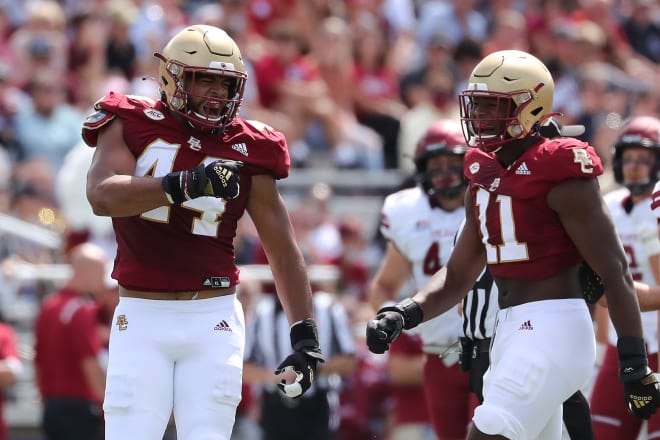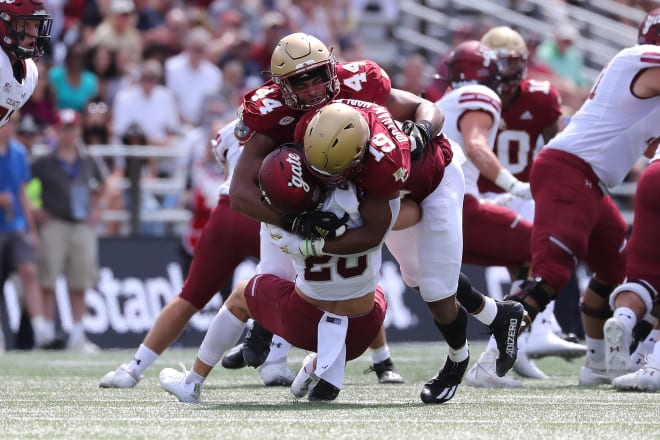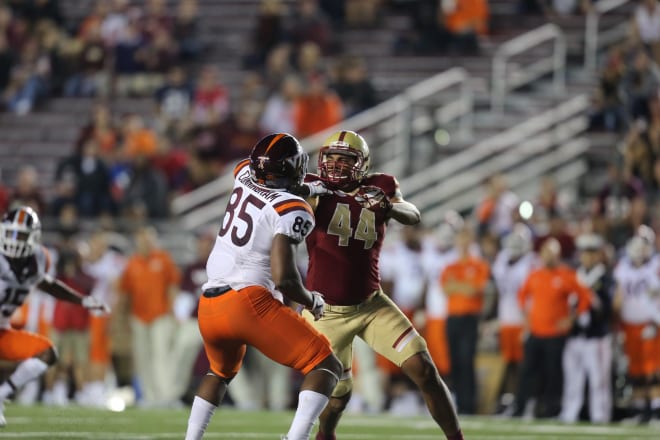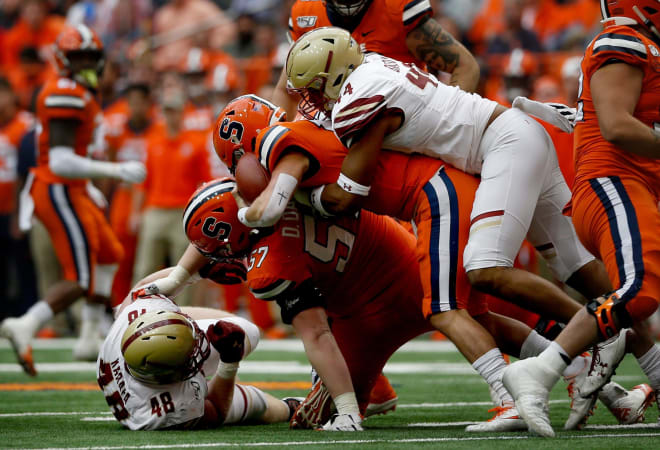Brandon Barlow: The Growth of a Program and a Man

THERE'S ROCK BOTTOM. And there’s Boston College athletics six years ago.
BC became the first major conference school since TCU in 1976-77 to go winless in league play for both football and men’s basketball. The Eagles were a combined 0-26 in the revenue sports.
The football team cratered following a promising first two campaigns under head coach Steve Addazio. After sniffing eight-win seasons back-to-back years, the Eagles experienced a free fall that resurfaced serious questions about BC’s shelf life in the ACC, which they left the Big East for in 2005 ahead of the most dramatic re-alignment in college football history.
While the program’s name was being dragged in the mud, its 2016 recruiting class—83rd nationally and dead last in the ACC—was blocking out the noise. Defensive end Brandon Barlow is one of four remaining Eagles from that group: a collection of players who committed to a program that was stripped of its dignity and helped restore its place in the ACC.
And now, thanks to the COVID-19 blanket waiver, Barlow and Co. have the chance to see it all come to fruition with a 2021 season that could be BC’s best in more than a decade.

BARLOW SAID IT all started with a group chat, where he and his fellow Class of 2016 commits supported each other and built confidence heading into their freshman year on the Heights.
“We all had the same mentality that we were going to help turn BC around and change it into a new program,” Barlow said. “At that point, I had no idea what that journey would entail.”
The 2015 Eagles ranked dead last in offensive SP+, averaging 275.6 total yards per game, the third fewest in the FBS. BC scored 206 points that season, and 100 of those came against FCS opponents Maine and Howard. Addazio lost his starting quarterback for the year in Week 3, and the Eagles threw everything they had at the wall to replace him, but nothing stuck. BC started three other gunslingers, including Doug Flutie’s nephew, a walk-on who later converted to fullback and a run-first signal caller who now lines up at wide receiver for the New York Jets.
BC’s saving grace was its defense: the top-ranked unit in the country that single-handedly kept the Eagles within three points of five of its ACC opponents that year. But, after the season, defensive coordinator Don Brown was poached by Michigan, which not only was a gut check to the Eagles’ coaching staff, but it also had long-term recruiting ramifications. For years since, Michigan has stolen top-rated Massachusetts prospects from East Coast schools, namely BC.
It was Brown and defensive line coach Ben Albert who got Barlow, an upstate New York native, on the BC wagon in March of 2015. A two-star recruit, Barlow was the second Eagles commit in the cycle. His father Reggie, who won multiple SEC Championships as a defensive tackle for Auburn from 1988-91, was initially hesitant about BC’s facilities and program trajectory.
That wasn’t stopping Brandon. He wanted to be part of a defense as prestigious as the Eagles’.
“That was his number one school right away,” Reggie said. “He knew that was where he wanted to go. And I said, ‘Well, let’s go look at some other schools and go check out some other programs. He goes, ‘Dad, this is the place I want to go. If they want me, I’m gonna want them.’”
Within 24 hours of Brandon’s visit, Addazio extended an offer. Brandon took it. Over the course of the next year, he had to transition from being one of the faces of Shaker High School’s football team to taking a backseat in BC’s defensive line room.
Coming from an area in the Northeast that’s often disrespected on the recruiting trail, Barlow found himself among a different level of competition in Chestnut Hill. Luckily for him, he had been brushing elbows with the big boys his entire career.
Barlow signed up for the sport at the same time as his older brother. Although he was in second grade, he wasn’t fooling around. He told Reggie that he didn’t want to play flag. He was eying the pads. And so a pudgy Barlow spent his first year in Mighty Mites on the offensive line.
“The next year we came back,” Reggie remembered. “I mean the kid grew so much they said, ‘Mr. Barlow, he can’t play at this level. He’s too big.”
To stay on the field, Barlow played two years up from third to eighth grade when the Shaker program, led by Greg Sheeler, called Barlow up to the freshman team.
“I think it all helped his fundamentals,” Sheeler said of Barlow’s playing maturity. “And I think that is what really made him such a great player for us, as he was so coachable.
“He had so many good habits already instilled in his game.”
SHEELER KNEW WHAT was coming. He met Barlow when he was a young child climbing the ladder in Pop Warner. He said he got to see Barlow metamorphosize from a chubby lineman to a tall, lanky defensive end. Even though Barlow knew he wanted to rush the quarterback when he committed to BC as a junior, he was a two-way player throughout his Shaker career.
More importantly, he was a team player. Barlow came into high school as an end, on both sides of the trenches. It was a preference he made clear toward the end of middle school when he grew frustrated with O-Line play. He felt like he had too much speed to be butting heads up front.
His first year on varsity, though, he was asked to move back to offensive tackle. Despite his weight—he was between 170 and 180 pounds back then—Barlow’s technique was enough to convince Sheeler that he was the man for the job. Besides, Shaker had a senior tight end that year so Barlow could have been splitting time there.
“He didn’t really want to do it,” Reggie said. “But you have to hand it to him, [he said] you know what, I’m going to do what’s best for the team. I’m going to put myself here.”
Sheeler discussed how Barlow’s hand placement and footwork put him in position to make the necessary block on offense and highlight-reel play on defense. Still, it was his effort that stood out the most, Sheeler said. He noted how impressive Barlow’s motor was for a high schooler.
That sophomore season, he was a Section II Class AA Liberty Division honorable mention, and Shaker made it to the Class AA Super Bowl in Albany, New York.
“And from there, he just took off,” Reggie said.

BARLOW EVOLVED PHYSICALLY, hitting the weight room hard. By the time he was a senior, he was a force. He piled up 68 tackles, including 9.5 sacks, and two forced fumbles in 2015, en route to becoming the Class AA Liberty Division Player of the Year and earning USA Today first-team all-state accolades. The problem was, the competition was hardly a precursor for the Power Five.
After Barlow’s first full-pad scrimmage at BC, he called Reggie.
“He said, ‘Yeah, I got to get a lot stronger. I got to get better in every way,’” Reggie said. “And I remember I asked him, ‘What happened?’ He said, ‘I’ve never been pancaked in my life. I got pancaked today by the third-team tackle.’ I said, ‘Welcome to big-time football.’”
It was an adjustment for Barlow: understanding that every player at BC starred at their respective high schools and most waited for their turn at the collegiate level. With future NFL defensive ends Harold Landry—who led the FBS in sacks in 2016—Zach Allen and Wyatt Ray spearheading the position group, there was a lot to absorb during his redshirt year.
“I kind of took everything I could from the guys ahead of me to try and build my own game that’s going to work for me and my playing style,” Barlow said. “It was important to stay hungry and to have that drive to get back on the field, which I had the whole time.”
Barlow made his first appearance in 2017, then saw his first extended action the following season when injuries to Ray and Allen on the D-Line freed up spots for him and Marcus Valdez against his hometown program, Syracuse. He parlayed a six-tackle performance against the No. 19 Orange into a starting role with BC the next season.
Barlow has started a combined 22 games over the past three years while registering 76 tackles, 11.0 TFLs and four sacks. He believes he really came into his own last season under the guidance of new defensive line coach Vince Oghobaase, who he calls the best position coach he’s ever had.
Oghobaase is fiery but didactic, instructing Barlow how to use his hands better when hunting the quarterback and teaching him more about the game than he previously thought possible. Under his direction, BC’s defensive line skyrocketed from 110th to 58th nationally in sacks per game, and Barlow notched the highest Pro Football Focus pass rushing grade of his career.

THE BRANDON OF NOW is almost unrecognizable from the Brandon of 2016. His hair has grown progressively longer. The chocolate-colored curls have sprouted like a beanstalk, forming a canopy over a smile that has grown exponentially in his media day pictures. The afro is currently styled in dreads, a few of which hang below his patient eyes. Not to mention that he’s tacked on an inch in height and 32 pounds of mostly muscle since arriving on campus five years ago.
Outside of the physical differences are heaps of personal growth. Barlow has earned a bachelor’s in communication, and fittingly so. He is one of the most well-spoken players on the team. At the moment, he is serving as an intern for BC Athletics’ communications department, in addition to pursuing a master’s in leadership and administration.
He went from calling his dad, his coach and mentor, every day to checking in once a week.
“Holy cow, what a transformation,” Reggie said. “We’ve been through the whole journey. It actually kind of brought tears to our eyes.”
Not only has Barlow changed drastically in the last half decade but so has the school and program he plays for. During his tenure, BC has had three different athletic directors: Brad Bates, Martin Jarmond and Pat Kraft. One gym was built, and another was torn down, as the Flynn Recreation Complex gave way to the Margot Connell Recreation Center.
Alumni Stadium and Conte Forum added beer and wine sales. Harrington Athletics Village—a baseball and softball complex on Brighton campus—opened, and those teams said goodbye to Shea Field with the construction of the Fish Field House, BC’s $52.6 million indoor practice facility. Jarmond started a five-year, $150 million capital campaign, the first of its kind in BC history. The Pete Frates Center, an indoor practice facility for BC’s baseball and softball teams, was unveiled. And BC dropped its partnership with Under Armour for an endorsement deal with New Balance and a football-only agreement with Adidas.
Addazio and his coaching staff found unheralded prospects like Barlow who could develop into far greater players than their star ratings indicated. BC got close to breaking free from the handcuffs of Power Five mediocrity, thanks to the program’s all-time leading rusher, AJ Dillon; a three-year starting quarterback, Anthony Brown Jr.; and a defense that produced a pair of Walter Camp All-American defensive backs as well as eight other players who ended up hearing their names called in the NFL Draft.
BC increased its tempo on offense and paired its elite rushing attack with an effective play-action passing game—a 12-personnel-heavy scheme that delivered the Eagles’ best scoring offense since 1993. Addazio got the Eagles within one game of the program’s first eight-win season since 2009 in two of his final three years with the team.
Hafley appears to be taking BC one step further, courtesy of a coaching staff adorned with NFL experience; a quarterback-friendly offense; and a receiving corps that’s as good as any in the ACC. BC has shifted from a run-first to a pass-first system and an old school head coach to a 42-year-old player’s coach who is a defensive guru and a recruiting wizard.
The laundry list of renovations, financial adaptations and team identity transitions are a snapshot of just how much can change within a FBS program and an athletic department in five years.
Barlow has been recruited and coached by four different defensive coordinators, four different defensive line coaches and two head coaches. His postseason experiences include a Pinstripe Bowl that was played in a frozen Yankee Stadium, a SERVPRO First Responder Bowl that culminated in the NCAA’s first-ever postseason weather cancellation, a Birmingham Bowl that was delayed by lightning for an hour and a half and a trend-setting opt out in 2020. He’s watched BC re-enter the AP Poll for the first time since 2008 and host “College GameDay,” only to regress again before rebuilding something more special with Hafley at the helm.
“I see nothing but positives for that program, even after Brandon leaves,” Reggie said. “And I just know, from watching my son since Coach Hafley’s gotten there, how much better [Brandon’s] gotten in a two-year stretch. It’s amazing.”
BC RETURNED 20 STARTERS across all three phases this fall, including Barlow, who spent most of his life playing with the older kids and now finds himself on the other side of things. In the ACC Preseason Poll, the program was picked to finish as high as third in the Atlantic Division for the first time since 2010 and is a trendy dark horse to make a run for the conference title.
This is a rare chance for the typically middle-of-the-pack Power Five teams to contend. With six sixth years and a 116 total players, BC is loaded with skill and experience. BC brought back the 11th most offensive production of any team in the country, according to ESPN’s Bill Connelly, namely all five starting offensive linemen who have combined for 125 starts at BC. And the Eagles have the second-easiest Power Five schedule, per PFF’s opponent ELO metrics.
Reggie said that it’s every former college football player’s dream to go back and play. Barlow gets to live out that dream as a 23-year-old with one last chance to suit up with his brothers. And, regardless of early-season injuries, maybe even contend for a championship, something BC hasn’t done in more than 10 years.
“We’re ready to take that next step,” he said.
“All of us sixth years and the whole program included, we are all ready to take this step.”